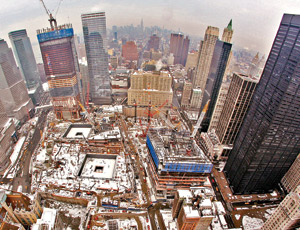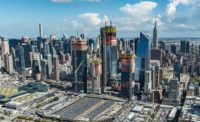Years after planners planted the seeds of redevelopment at the World Trade Center complex, the 16-acre site in lower Manhattan shows significant signs of life. Cranes are in motion and crews are fully mobilized at towers two, three and four, ending a difficult period in the project’s progress and offering hope that the vision of these buildings will finally be realized.

The three buildings seemed destined to be top construction starts of 2008. Following years of delays, the Port Authority spent much of 2008 preparing the site for New York developer Silverstein Properties to bring the towers out of the ground. But bitter disputes broke out over the Port Authority’s site turnover obligations and heated arbitration ensued for nearly two years.
In a February 2010 interview with “60 Minutes,” developer Larry Silverstein called the pace of the World Trade Center construction a “national disgrace.” But soon after, the tide began to turn.
On March 25, 2010, the parties reached an agreement that settled their differences, and established a plan for how to build and finance the project moving forward. As part of the agreement, the Port Authority, New York City and New York State agreed to contribute $1.6 billion in public money. The agreement was finalized and signed in August, but it was the tentative deal in March that put construction on these three towers back in motion.
Tower Two
Construction of Two World Trade Center, the 78-story building designed by Norman Foster, was among the most tentative projects in the plan for years. Crews returned to foundation work in June 2010, reanimating a project once thought dead after plans were circulated in May 2009 to scale the tower back to a four-story “stump” of retail space.
Silverstein opposed the downscale and secured funding to keep the original design: Rising to 1,278 ft, it features a sloped, diamond-shaped roof and is shaped as a “wedge of light” by designer Daniel Libeskind to keep shadows away from the WTC Memorial on Sept. 11.
Although it is the only Silverstein tower without a projected completion date and the agreement allows for flexibility for future development, the project’s general contractor, Turner Construction, is proceeding with original plans, says Gary Negrycz, vice president at Turner. “Everything we are building is from the original design, which of course is for a 78- to 80-story building,” he says.
Minor milestones are already being met. In February, crews began pouring concrete into the first wall. “It made me feel pretty good,” Negrycz adds. “We worked really hard to get to that stage.”
While the foundation work is more than 90% complete, Negryz does not expect construction to reach above street level until the end of this year.
Stakeholders contend that public criticism over the pace of construction stems, in part, from the fact that pedestrians cannot see the extensive work being done below street level. Negrycz argues that the below-grade construction has been some of the most complicated, extensive, time-consuming and vital work.
“You go in your car, and you have a seat, a stereo and a steering wheel,” Negrycz says. “That’s very well and good, but most of what makes that car really work is under the hood.”
Tower Three
In July, Tishman Construction, New York, restarted foundation work on Three World Trade Center, designed by Richard Rogers, after a false start in 2008.
Article toolbar


Post a comment to this article
Report Abusive Comment